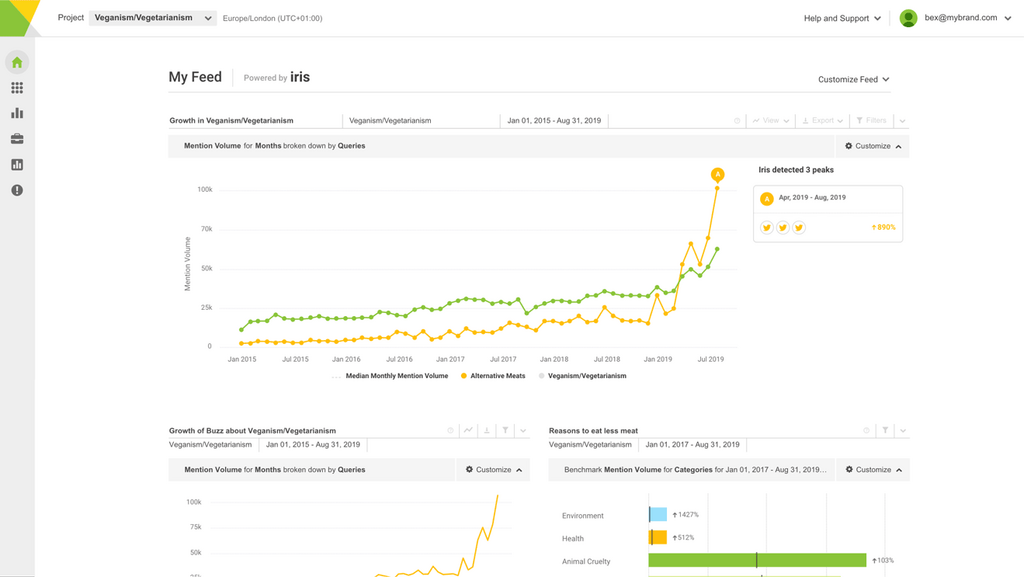10 Social Listening Tools and Who They’re Best for
By BrandwatchJul 14
Join us and boost your social media potential with our data-led event
Published December 15th 2016
Life as a marketer can be difficult. You develop a brilliant campaign, design the perfect assets and craft the perfect copy. Then ad blockers reduce your audience. Facebook changes its algorithm.
Suddenly nobody is seeing your work without a promoted post. Running alongside these problems is the explosion of content marketing, the rise of instant gratification, and the death of the attention span.
Oh look, a man in a field! Sorry, where was I?
Often, you have seconds to connect with someone. This competitive and overcrowded content landscape and lack of attention is forcing marketers to create a better, more personalized experience for the consumer.
We’ve written a lot about the age of the customer, and how bringing consumer insights into your business for segmented marketing is the route to success in this competitive world. The current goal in this evolutionary journey is to reach a single customer view, allowing brands to engage in one-to-one marketing.
There is an argument put forward by people who don’t quite understand the theory of evolution, which states that an eye is of no use until it is fully formed. The argument goes that the eye could therefore not possibly have evolved by natural selection.
Actually, any advantage, however small, means an organism is better placed to pass on its genes. Being able to detect a change in light might just be enough to beat the competition, and eventually lead to the evolution of a fully formed eye.
You could view one-to-one marketing in a similar light. For some, the technological and structural changes needed make it seem so far away as to feel an impossible goal to strive for. I would argue that much like the eye, any small advantage conveyed by an advancement, however small, helps you to beat your competition and continues you along the path of evolution to marketing greatness.

One-to-one marketing is a strategy that uses data collection and analysis, and digital technologies, to deliver personalized marketing. Advancements in marketing technologies have allowed this field to become increasingly advanced.
HBR reports that personalization can deliver five to eight times the return on investment for marketing spend. The return increases the more mature your personalization is. Analysis of millions of email subject lines shows that including a name only had a marginal impact on engagement, but emails triggered by certain actions got 3 times the open rates and 2 times the click through rates.
The first step in one-to-one marketing is collecting the data. Combining sales, social and behavioral data will uncover meaningful insights about customers.
This information can then be fed into advanced analytics models, which calculate the probability of a consumer responding to different types of content. The response to the chosen content can then be fed back into the system, tracking consumer reactions to inform future strategy.
Final, content distribution systems will use this information to deliver one-to-one marketing messages in the right place at the right time. This should trigger personalized landing pages, tailored offers, and targeted ads.
For this to work, different technology systems and data silos need to be able to talk to each other, allowing freedom of data movement and real-time, automated decision making.

While that level of data integration and automation might seem daunting to many, the eye was not ‘created’ in one go. Similarly, one-to-one marketing doesn’t need to be an all-or-nothing discipline.
There are degrees of personalization, and beginning now can boost immediate results while laying the groundwork for further future development.
The first step is to research your customer and prospect base and segment the market. Social intelligence can deliver detailed information about your customers, going beyond their interactions with you and uncovering more about them as a rounded human individual.
Building buyer personas can help by allowing you to focus on an imagined individual who is representative of the group. These broader, top level groups can allow you to tailor your content and delivery. The Hubspot blog is split into sales and marketing, and while I’m sure Hubspot knows more detailed information, the separation is useful for the end user.
You can start with the top-level segments like this, and continue to add in more information as your capabilities allow. Using names is an early step, and purchase history should be fairly easy too, but before too long you’ll have weather behaviors too.

Taking this research about your customers and beginning to develop personalized marketing is possible for most brands. Some of the early vehicles for this personalization are as follows:
Pay Per Click – Essentially sponsored search engine results. Your market segmentation, in collaboration with keyword research, can reveal that different buyers have different intent, and search with different keywords. This means you can tailor PPC advertising accordingly, making the ad seem more relevant to that user. Real-time events may also provide an opportunity to personalize further.
Retargeting – Display ads can re-engage people who have visited your site but bounced. These ads are displayed on other sites, displayed only to people who have expressed an interest in your brand or a particular product.
Social media – One of simplest current methods of personalization, as social networks do the hard work behind the scenes. A variety of targeting options are available including location, profession, age, gender, interests, or behavior.
Website – You can personalize your website for repeat visits based on an account system (think Amazon tailoring your recommended purchases) or using cookies (think millions of websites everywhere).
Email – Segment your email database to deliver different content to different groups. In B2B that could be by industry, job title, or the stage in the buyer journey.
Beginning the journey towards one-to-one marketing can help to build momentum in the fragmented, multiple-touchpoint modern customer journey. Making sure your messaging is relevant and speaking the right language is an important first step that quickly shows results.
When it’s survival of the fittest, any advantage will give you the edge over your competitors. As your marketing capabilities evolve, bringing more complicated data into the equation will help you stay ahead of the game to become the apex predator in your industry.
Offering up analysis and data on everything from the events of the day to the latest consumer trends. Subscribe to keep your finger on the world’s pulse.
Consumer Research gives you access to deep consumer insights from 100 million online sources and over 1.4 trillion posts.
Existing customer?Log in to access your existing Falcon products and data via the login menu on the top right of the page.New customer?You'll find the former Falcon products under 'Social Media Management' if you go to 'Our Suite' in the navigation.
Brandwatch acquired Paladin in March 2022. It's now called Influence, which is part of Brandwatch's Social Media Management solution.Want to access your Paladin account?Use the login menu at the top right corner.



